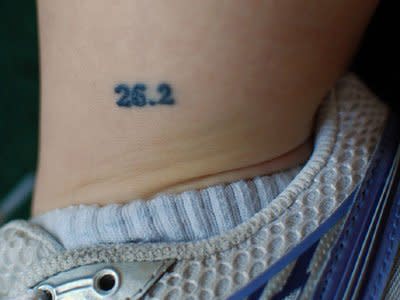Want to run a marathon? Here’s what it takes to finish one

This Sunday is the 42nd New York City Marathon. More than 40,000 people will run 26.2 miles in the five boroughs, making it the largest marathon in the world. The allure of such a great physical test is tempting for professional athletes, everyday runners, and celebrities alike. Heck, Drew Carey, Oprah, and Al Roker have all gone the distance.
Video: Preview the NYC marathon's events
You don't have to be a lifelong runner to train for a marathon. Runner's World recommends 16-week beginner training plans for people who have run for at least one year and regularly average 15 to 25 miles per week. If you watch the race and think that maybe you'd want to try a marathon, too, here's what it takes to go 26.2.
A RACE TO TARGET
Many marathons are in the spring or fall, but pick one that your local weather will allow you to train comfortably for. Although you can get in some good running on a treadmill, most marathoners say that the best preparation for an outdoor race is training outdoors as well. If you live in southern states, a winter or spring marathon will mean less training in the summer swelter. If you live in midwestern states, training for a spring race through the extended winter's cold and snow would be difficult, so a fall marathon may be best. Once you've picked the race, sign up right away. Getting it on the calendar will jump-start your motivation.
Get Going: Find a race near you
A TRAINING PLAN
Next, you need a training plan that outlines when and how much to run and when to rest. Runner's World's beginner marathon plans call for four days of running and three days of rest per week. These are all easy runs with a focus on the long run. The long runs start at five miles and gradually build to 20 miles, usually adding on two miles per week (plus a few cut-back weeks to give your body a chance to recover). Two or three weeks before the race, you'll reduce your weekly mileage so your body is well rested for the big day.
Try these exclusive Runner's World Training Plans
So, why only go up to 20 miles when the race is 6.2 miles longer than that? People generally run faster on race day than they do during their training runs, thereby covering more ground in the same time. That, plus on race day, you'll be strong and rested and there will be cheering spectators. Running those last six miles in training just isn't worth the risk of injury.
A GOOD PAIR OF SHOES
You'll be running more miles than you ever have before so it's important to have high-quality footwear. Head to a specialty running store to have your gait analyzed. The employees will recommend a shoe that has the right balance of support and cushioning for your body. Here are our best tips for buying the right shoes for you.
Our experts solve your shoe conundrums
LONG RUNS
Long runs are the most important element of marathon training. For first timers, their purpose is to get you used to spending long periods on your feet. Since these workouts are much longer than the majority of your runs, they require a few special considerations:
1. Eat on the Run
On runs 75 minutes or less, you can rely on your body's glycogen stores to power you through. But on longer runs, you need carbs and electrolytes. You don't have to slurp down gels if you don't want to-real food like pretzels or Fig Newtons will do, but can be more unwieldy to carry. There are also several kinds of sport chews-think of them as nutritious fruit snacks. You should start taking in carbs between 30 and 60 minutes into your workout. The ideal is 100 to 250 calories (or 25 to 60 grams of carbs) per hour, after the first hour of running.
2. Refuel Quickly
Eat a snack containing carbs and protein within 30 minutes of finishing your run. Carbs will top off your glycogen supply and protein will help repair muscles that were stressed by the run.
3. Cool Down
Taking a 10 to 20 minute ice bath or cold water bath will help reduce inflammation and soreness. Fill the tub with just enough water to cover your legs. Multitask by having your post-run snack while you soak. Wrap your upper body in a towel or wear a sweatshirt to stay warm.
Making your long runs count
On race day, your goal should be to cross the finish line smiling-you can worry about hitting a certain time during your second marathon. If you're interested to know about how long it will take you, Runner's World Chief Running Officer Bart Yasso says you can expect to run about 10% faster per mile in the race than you do during long runs.
Are you race ready?
Tell us: Is anyone training for their first marathon? Anyone considering signing up for one in 2012?
More from Runner's World
The Top Running Shoes of the Season
Must-Run Marathons for Every Runner
Free Training Guides To Help You Get Faster
Get customized plans to start running faster, longer, and smarter!

